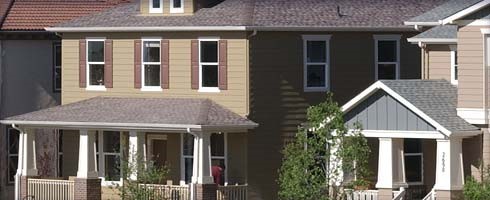An urban infill redevelopment that transitioned the decommissioned, 4,700 acre Stapleton Airport into a residential development with retail, office, industrial, and warehouse distribution space.
Stapleton International Airport started in 1919 as an airfield and became the Denver Municipal Airport in 1929. The airport grew with the City over the years, but in the late 1980s City leaders decided Denver’s needs had outgrown the facility, and a decision was made to open Denver International Airport, 15 miles to the east. In 1995, Stapleton International Airport closed.
The Stapleton Foundation was established in 1990 to develop a visionary plan for the redevelopment of the soon to be vacated Stapleton Airport. In 1995 the Foundation published the Stapleton Development Plan (often referred to as “the Green Book”), which called for integration of jobs, open spaces, and community into a new mixed-use residential neighborhood. The Green Book was approved by Denver City Council in 1995 and continues to serve as the guiding document for the site today.
In 1998, Forest City Enterprises, Inc. was selected as master developer to work with the City of Denver, Stapleton Development Corporation, Stapleton Citizens Advisory Board, Stapleton Foundation, Westerly Creek and Park Creek Metropolitan Districts and DURA to make the Stapleton Green Book a reality. At more than 4,000 acres, redevelopment of the former airport required rehabilitation, infrastructure improvements and public services on a very large scale. Working together in a public-private partnership, Forest City, the Districts, the City of Denver, Denver Public Schools, Denver Water and DURA are in collaboration to finance and construct the roads, sewers, parks, schools and community facilities needed to effect redevelopment as called for in the Green Book.
To date, DURA has issued $462 million in bonds to help finance regional infrastructure improvements such as roads, parks, fire stations, schools and other public projects. At build-out, the 4,700-acre, $3.4 billion redevelopment will comprise more than 12,000 market-rate and affordable rental and for-sale residential units, 3.9 million square feet of retail space, and more than 10 million square feet of office, industrial, and warehouse distribution space. Upon completion, Stapleton is projected to grow Denver by more than 30,000 new residents, 13,000 jobs and approximately 1,100 acres of new parks and open space.
Like Lowry, Stapleton is widely recognized as one of the country’s largest and most successful infill projects. Denver’s approach to redeveloping Stapleton has become a model for other communities and has received national recognition through awards from the Environmental Protection Agency, Housing and Urban Development, Urban Land Institute, and the United Nations Council on Sustainable Development. In 2002, Stapleton received the prestigious Stockholm Partnerships for Sustainable Cities Award from the King of Sweden, in recognition of the project’s commitment to sustainable development, community-building and environmental stewardship.
